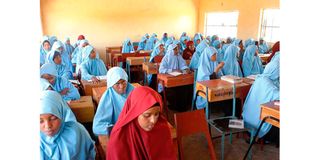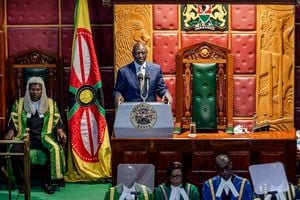What's keeping North Eastern girls out of school?

Students in a class at Khadija Girls Secondary School in Mandera County. Mandera, Wajir and Garissa counties had the highest gender gap with a ratio of almost one girl to every two boys in the KCSE class of 2020.
What you need to know:
- While releasing the 2020 KCSE results in May this year, Education CS George Magoha, raised concern over a high gender parity in Mandera, Wajir, Garissa, Turkana and Homa Bay counties.
- Parents are quick to withdraw girls from school to take care of grandparents, forcing some of them out of school.
- A parent with an unmarried girl in his homestead can never be respected by his peers
Sixteen-year-old Halima (Not her real name) from Mandera scored 325 marks in the last Kenya Certificate of Primary Education (KCPE).
Despite scoring a grade that would see her through a good secondary school, her father tried to marry her off. At a time the government was working on ensuring all students join high school, Mandera County Principal Chief Issak Adawa led a team who rescued the minor. Halima’s father and suitor were apprehended for their action.
The 16-year-old girl’s story is an example of many other girls from north eastern region, who have missed out on secondary school education due to retrogressive cultural practices.
So rampant is the problem that Mandera’s top girl in KCSE Rahma Ibrein, who scored a B plus of 68 points, lauded her father for protecting her from early marriage, ensuring she completed her secondary education.
Gender gap
While releasing the Kenya Certificate of Secondary Education (KCSE) results in May this year, Education Cabinet Secretary George Magoha, raised concern over a high gender parity in Mandera, Wajir, Garissa, Turkana and Homa Bay counties.
Prof Magoha noted that Mandera, Wajir and Garissa had the highest gender gap with a ratio of almost one girl to every two boys in the class of 2020.
“There was almost one to two gender gap in Mandera, Wajir, Garissa and Turkana. I therefore, direct the field officers in these counties to find out what is happening with the girls there. Are they marrying them too early? We must find out what is happening and bust them,” Prof Magoha said.
Data from the Kenya National Examination Council indicate that male candidates in Wajir were more than double the number of females who sat for KCSE in 2020.
Out of 4,542 KCSE candidates in Wajir, only 1,485 were female. In Mandera, there were 1,330 female candidates against 2,781 male who sat for KCSE in 2020.
Female learners
The 2019 Census data also shows a trend where the gender gap widens in secondary school and higher learning institutions.
In 2019, for instance, there is a near gender balance in pre-primary entry with 7,713 male and 7,310 female learners in Wajir. However, there were 14,413 male compared to 9,759 female students in secondary school during the same period.
In Mandera, the Census report shows there were more girls than boys in pre-primary school but the number of girls was lower in secondary school.
Nur Bardat, a Kenya National Union of Teachers official in Wajir County, acknowledges that most of the girls who complete primary school do not transition to high school due to local customs.
“In fact, there are too many girls at the lower classes who perform better than boys. But unfortunately, the numbers and performance decline in upper classes. The dropout rate is largely due to early marriage,” Mr Bardat says.
He observes that parents too, play a major role in keeping girls out of school by engaging them in domestic work.
“In the Somali culture, parents are quick to withdraw girls from school to take care of grandparents, forcing some of them out of school. Any time there are some chores to be attended to, parents will not hesitate to ask the girls to abandon school and stay at home. It is a tradition we are fighting gradually,” he says.
Early age
Mr Bardat explains that parents who are still bound by the Somali culture will not hesitate to marry off their girls at an early age.
Hon Khalif Girls’ Secondary School Principal Osman Mumin says that while the enrolment of girls in Wajir has improved, cultural and infrastructural barriers remain a challenge.
He also cites instances where some residents prefer that girls acquire religious education before formal education.
“It is believed that when girls go through the religious classes first, they can withstand the influence of young men. This is common among the illiterate folk. The pastoralists also prefer taking the boys to school while girls take care of the animals. This may be contributing to the disparity,” Mr Mumin says.
Mandera County Director of Education Abdi Roble admits that early marriage is a major hindrance to girl child education.
“We have girls being married off at a young age of 13 years, by parents who still don’t see the value of educating them. The cases are rampant in the rural areas across the county,” he says.
Low entry
Mr Roble also cites low entry points to secondary schools by girls and lack of role models as causes of girls’ poor academic performance.
“We don’t have role models locally to boost the academic morale of these girls. What they see are fellow girls who drop out of school to start families. This can have a significant impact on their psyche,” he says.
Mr Roble admits that management of girls’ schools by male teachers due to shortage of women teachers, was affecting mentorship of girls.
“We need to have more female teachers to fill the gap in the girls’ schools but there are none in the county to play that role,” the director says.
In Somali culture, a man can book an underage girl for marriage several years before they move in.
Gender norms where girls are expected to be virgins before marriage and the need to have many children are cited as major drivers of early marriage.
Stigma around women who are married after they turn 18 years is also believed to influence cases of early marriage.
Herd goats
“A parent with an unmarried girl in his homestead can never be respected by his peers. He is considered a failure in family matters and cannot be allowed to advise anybody outside his family,” says Ms Abdia Hassan, a Mandera resident.
Ali Hassan another resident, says in some areas girls’ education is still disregarded leaving them to do household chores or herd goats.
“Some girls still believe education has no value and therefore, do not strive to work hard in their academics. They see boys as the beneficiaries of education since girls who perform well are not held highly,” he argues.
Mr Mumin, however, says the perception about girls’ education is slowly changing where Hon Khalif Girls’ Secondary School has doubled its population in the last four years.
“I joined the school in 2016 when the population was at 265 but today, the number has almost doubled with about 500 girls. There are also a few cases of dropouts. We have had four early pregnancy cases over the period and all of them came back to school after delivery,” he says.
According to the Adolescent Girls Initiative-Kenya baseline report of 2015, one in four girls in Wajir had never attended school.
Luckily for Halima, the trap of early forced marriage has evaded her, as she is pursuing her secondary education – the hope of many girls in the north eastern.
This story is done with support from Journalists for Human Rights (JHR) under a media development project titled “Canada World: Voice for Women and Girls”
Additional reporting by Manase Otsialo





